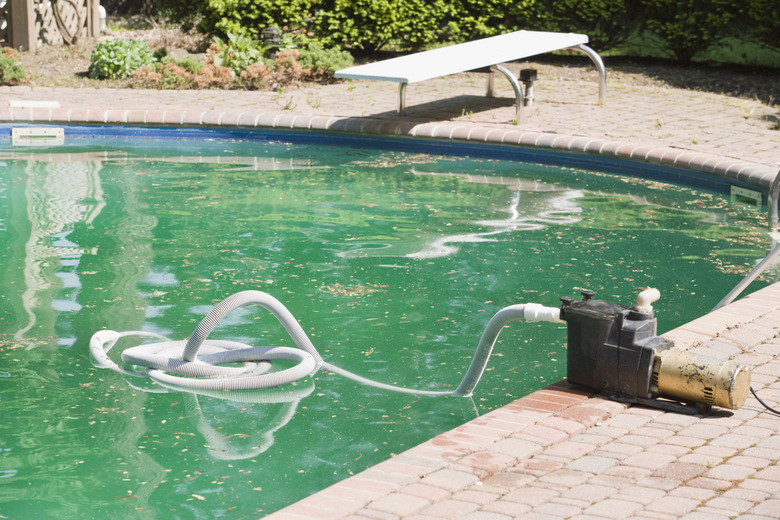Home Remedy For Cloudy Pool Water
Whether the cloudiness in your pool is the result of poor filtration, chemical imbalance or just overuse by people wearing an abundance of sunscreen , the easy way to remedy it is to use flocculant. Floccing the pool is a temporary solution, but it works more quickly than adjusting the chemical balance, and it's effective. It's also inexpensive; all you need is your pool vacuum and a container of flocculant, which costs less than $20. You could also use pure aluminum sulfate — which is the main ingredient in flocculant — but it isn't significantly less expensive.
Floccing Vs. Clarifying
Floccing Vs. Clarifying
Pool flocculants and clarifiers are both coagulants, and they work in roughly the same way. When you disperse either product in the pool water, the molecules attract particles from the water to form clumps. When you use a clarifier, you typically leave the pool pump on. The clumps get caught in the filtration system, and you either backwash the filter or clean it to get rid of the impurities.
Floccing is for more severe clouding. The clumps formed by a flocculant sink to the bottom of the pool, so the filtration system has to be off. Flocculants work faster than clarifiers, and they are more effective — but there's a catch. You have to remove the debris yourself with a pool vacuum, so it's more work. Moreover, you end up sucking a significant amount of water out of the pool, which has to be replaced.
How to Floc a Pool
Adding pool clarifier to the pool water is easy — just follow the instructions on the container, and clean the filters when you're done. Floccing is a bit more complicated, in part because it's important to avoid disturbing the water until the vacuuming is completed. Here's one way to do it:
Things Needed
-
Pool chemicals
-
Commercial flocculant or pure aluminum sulfate
-
5-gallon bucket
-
Pool vacuum
1. Clean the Pool and Balance the Chemicals
Skim all debris off the surface, and then add chemicals as needed to balance the pH, total alkalinity, calcium, chlorine and cyanuric acid levels. If you've already been maintaining the chemical balance, you won't have to do much extra work at this point.
2. Add Flocculant
Whether you use a commercial flocculant or pure aluminum sulfate, it's best to dissolve it in a 5-gallon bucket of water before broadcasting it into the pool. When using a commercial flocculant, follow the directions on the container to get the proper proportion. If you use aluminum sulfate, add 4 pounds per 10,000 gallons. You'll probably have to mix more than one bucket.
3. Circulate the Flocculant
Run the filtration pump on Recirculate for about two hours. Be sure to select Recirculate, because you want the flocculant to bypass the pool filter. If your system doesn't have a multiport valve, don't use it to circulate the water or the flocculant will get caught in the filter. Instead, agitate the water with a pool brush.
4. Vacuum the Sediment
After two hours, turn off the pump and leave it off for 12 to 24 hours. At the end of this time, you will see a cloud of sediment at the bottom of the pool. Set the pool vacuum to Waste and lower the nozzle gently into the water to avoid disturbing the sediment. Starting at one end of the pool, vacuum all the sediment slowly. Then use a garden hose to replace water that you suck out.
Tip
If the cloudiness has a green tinge, algae may have started to grow. To control it, add 2 to 4 pounds of shock per 10,000 gallons when you add the flocculant.
Cloudiness Due to Elevated pH
Cloudiness Due to Elevated pH
Before you floc the pool, you should check the chemical balance, and if you notice the pH is too high, that may be why the pool is cloudy. You may be able to clear the water by adding muriatic acid to lower the pH. Consult a table to determine the proper amount of acid to add to bring the pH from where it is to where it should be. Circulate the water for an hour, and then recheck the pH. Add more if needed. If the pool is still cloudy after the pH is lower than 7.8, you probably need to floc.
